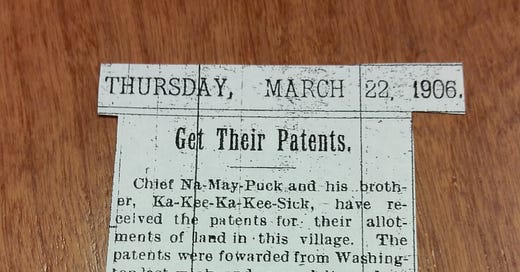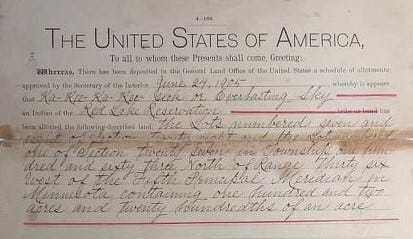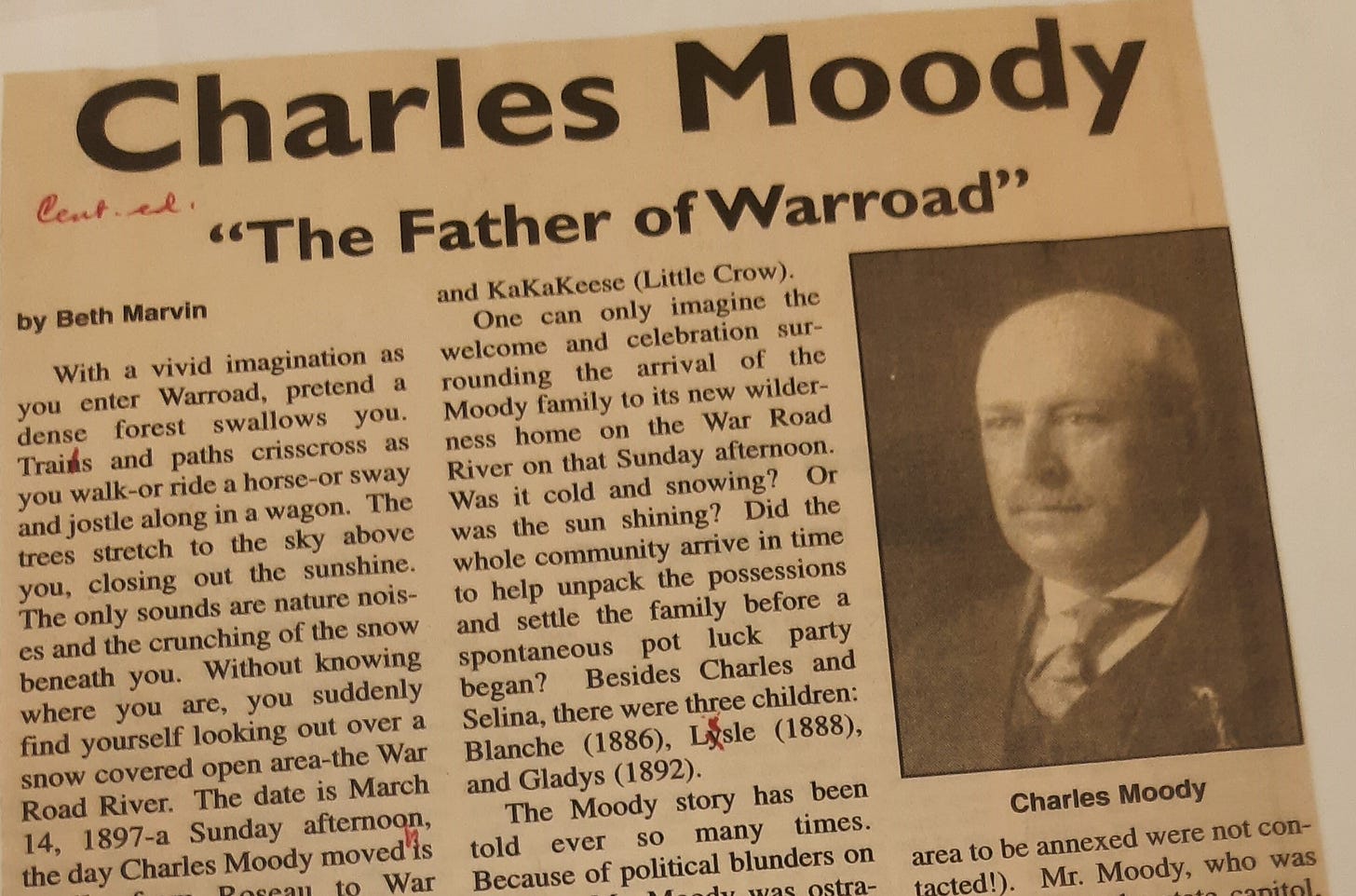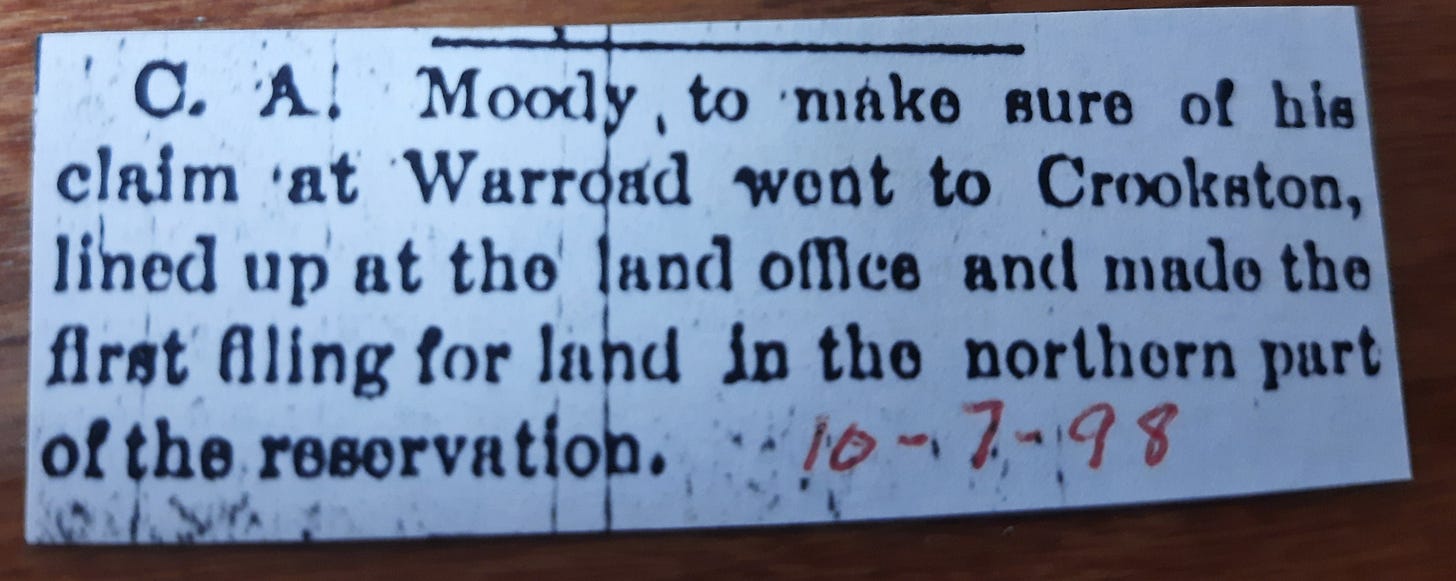When my mother died in June of 2014, I returned after 40 years to Lake of the Woods where she grew up and where I had spent my summer vacations as a child. I had come back to see my mother’s sister, Aunt Audrey, and learn more about my maternal great-grandparents who I came to understand had homesteaded on unceded Red Lake Reservation land.
I wondered whatever happened to Kakaygeesick, an Ojibway medicine man, who I met in Warroad, Minnesota, when I was 10 years old and whose photograph is on a souvenir postcard. When I learned his great-grandchildren had been forced off their land in 2012 by Red Lake Nation, I wanted to know how this could happen.
I met Kakaygeesick’s great-grandson to find out more. Donald Kakaygeesick showed me the original allotment papers his great-grandfather received from the federal government.
The land in Kakaygeesick’s allotment is the subject of my forthcoming book, and more recently I began to investigate the allotment issued to his brother, Namaypoke.
There weren’t supposed to be any allotments of Red Lake Reservation. Red Lake had been exempt from the 1887 General Allotment Act. Medwegannonind, head of the seven hereditary chiefs of Red Lake Nation, agreed in 1889 to cede additional lands as long as there were no allotments. So, what accounts for these three allotments issued in 1905?
I have spent a decade trying to find out how these three came to be without much success. That is until this summer when I returned to take a deeper dive further back into the local historical archives.
In learning more about the formation of Roseau County and its eastern boundary expansion, one name kept appearing. Mr. Charles A. Moody.
From my investigations into the origins of the Warriors as the Warroad School mascot, I knew Mr. Moody had been president of the first school board for the Independent School District in 1904 when they agreed to purchase the 4-acre parcel of land from Chief Naymaypoke.
That the school board president authorized a payment of $150 to Naymaypoke before the official allotment papers arrived had given me reason to pause. In my deep dive into the local archives, I found it wasn’t until March of 1906 when the documents arrived from Washington, DC.
I couldn’t help but ponder the proximity of Mr. Moody’s land across street from the proposed school lot on Naymaypoke’s land. And I certainly recognize where the name Moody appears vertically on the right to be the center of the city of Warroad today.
As a recurring character in the local history of Warroad, Mr. Moody plays a starring role as “Father of Warroad.” One of the earliest settlers who had not been brought here by the fur trade but by the opportunity for free land, Mr. Moody is what the face of encroachment looked like in the Ojibway village of Kah-bay-kah-nong.
Ten years before the school board acquired title to Naymaypoke’s land, Mr. Moody had been a central character in the creation story of Roseau County. He had successfully lobbied for the division of Kittson County in 1894; and then as the new Roseau County Auditor, Moody successfully orchestrated the annexation of unceded Red Lake Indian lands east of Warroad on the south shore of Lake of the Woods into Roseau County two years later.
In reading the local newspaper archives, I came across a small item which appeared in March of 1896, a month after the governor of Minnesota had approved the annexation. The Roseau County Times reported that a draft of a bill had been submitted to “Big Ed,” referring to Republican State Representative Edward Everett Smith, from Minneapolis. The bill requested from the state legislature an exception to opening the lands in the yet undiminished Red Lake reservation lands. According to the newspaper account, it specifically proposed granting Naymaypoke, Kakaygeesick, and Animikeese each “a patent for 160 acres in lieu of allotment” on the diminished reservation because the lands “have been occupied by these Indians and improved to a considerable extent and they agree to remain on them, as they consider them their homes.”
Eureka! The initiative to recognize these three land parcels as reserved from land claims by white settlers began in Roseau with Mr. Moody, County Auditor.
Who is this Mr. Moody? Where did he come from and how did he have so much sway in the state capitol to create a new county, annex Indian land, and abrogate treaty obligations?
Born to Joseph and Amanda Moody in 1863 in Illinois, Charles moved as a boy with his family in 1871 to the township of St. Anthony in what would become part of the city Minneapolis. During the Civil War, his father had secured government contracts to provide Union troops in the South with provisions. When the war ended, Joseph Moody continued to travel to southern states in his mercantile business and then plowed his profits into real estate ventures.
In 1874, when Charles was 11 years old, the Moody family moved north to Sauk Rapids, Minnesota, in what was then known as Benton County. His father expanded his real estate portfolio in their new hometown. Joseph Moody was appointed County Coroner and Justice of the Peace. He also served as chairman of the town committee for the Democratic caucus. His wealth and political status grew in Sauk Rapids and the state.
The eldest of four children, Charles Moody owned a billiard hall and served as an officer in the Masonic and Oddfellows lodges by the age of 21. He played the lead roles in the local drama club’s theatrical productions. The local newspaper reported in April of 1884 that the 21-year-old, C. A. Moody, planned to build a new house on the property adjoining his parents. Four months later, the paper printed the announcement of the marriage of Charles Moody to Miss Selena Dowsland of Sauk Rapids. Then suddenly Joseph Moody died after a short illness.
Charles Moody assumed his father’s responsibilities as County Coroner and Justice of the Peace. And in October of 1885, he also won the Democratic nomination for the Clerk of Courts in Benton County. He won the election, sold his billiard hall, and became involved in real estate and politics, following in his father’s footsteps.
By 1890 the entire Democratic party ticket in Benton County was elected by a wide margin. His father had spent many years hoping one day to the see Republican control of state politics come to an end.
In 1891, Charles Moody made newspaper headlines for organizing the North Star Democratic Club. His efforts to vote the old guard out of office backfired and the Democratic Party of the State of Minnesota let him know it had no further use for him. Moody found himself mocked and ridiculed by newspaper editors and Democrats across the state.
So Moody switched political parties and began to campaign for Benton County Auditor. He did not win the election. The Sauk Rapids newspaper reported that “as a reward for his treachery” to the Democratic Party, Moody had been appointed Deputy Collector of Customs in September of 1893 along the Canadian border, about as far north from the state capitol as possible.
This is what brought Mr. Charles Moody to Roseau. At first I thought from all the newspaper articles and editorials that Mr. Moody had been run out of Benton County by the Democrats and landed a patronage post from the Republicans as a consolation. But it was about more than party loyalty.
When he was Clerk of Court in Benton County, Moody embezzled $2,000. The funds had been deposited with him in trust as indemnity to the owners of lands taken by the Northern Pacific Railroad Company. Moody admitted he had taken $1,300 of the missing funds. It wouldn’t be the last time reporters would raise questions about Moody and land sales to the railroads.
Apparently no one in Roseau had any knowledge of his malfeasance when the Kittson County Examiner reported Moody had been appointed to Roseau. Instead, the news item suggests a more favorable view of his change in circumstances: “Mr. Moody, who has been the clerk of the court of Benton County for some time, resigned his office for the customs position.”
Charles A. Moody, his wife Selena, and his widowed wealthy mother Amanda moved from Sauk Rapids to Roseau in the fall of 1893. Moody immediately began to campaign for the creation of Roseau County. His newly established ties to Republican Secretary of State Albert Berg and the new Republican Governor Knute Nelson served his vision to do what he saw his father had done for his country by cultivating commerce across the frontier.
For Moody, the frontier was to the east of Roseau. The promise of Indian lands to be ceded for homestead claims presented him with a business opportunity to redeem the reputation of the family name.
Charles A. Moody moved his family from Roseau to Warroad in 1897 and he was the first to file a preemptive claim at the Crookston Land Office in October of 1898 on Red Lake Indian lands not yet ceded by treaty agreement.
In the next installment, I promise to share more about what I learned about Mr. Moody, the creation of the Warroad Townsite Company, land speculation, and what happened to the rest of Naymaypoke’s allotment not sold to the school district in 1904.









Thanks for digging this all out! Makes me grateful to have independent scholars like you working on truth telling. I just recently encountered a similar example of "encroachment" by a land speculator. It was a generation earlier and around the Omaha Reservation in eastern Nebraska, but the narrative thread and the outcome were very similar to what you've documented. I'm thinking that this is a common untold story around a lot of reservations.
And yet she persevered!! Bravo! This is excellent — and moody is aptly named for a villain. Congrats on connecting these dots